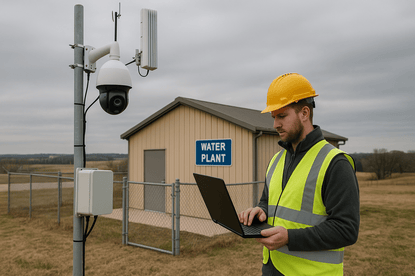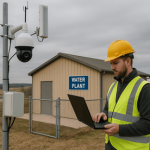
Cloud platforms are changing how municipalities manage security. But what happens when your city hall, water plant, or library sits on a shaky ISP with limited upstream bandwidth and occasional outages. Good news. You can still modernize government facility security systems without perfect internet. The key is choosing an architecture that respects rural constraints and keeps people and property protected every hour of the day.
This guide explains how to design public building surveillance and secure access control for city buildings that run reliably on small-town networks. You will find practical choices for bandwidth, storage, credentials, and failover so upgrades deliver the benefits of the cloud without risking downtime.
k
k
1) Start with a connectivity profile
Before picking hardware or licenses, map reality.
-
Uplink and downlink at each site during business hours and after hours
-
Latency and jitter to the closest cloud region
-
Monthly data caps or throttling rules from your ISP
-
Outage history including weather events and planned utility work
-
Cellular coverage for LTE or 5G and line-of-sight options for fixed wireless or satellite
A one-page profile per facility lets you size cameras, bitrates, and retention tiers with confidence.
k
k
2) Use a hybrid cloud model
Pure cloud is attractive, but rural networks often need local brains.
-
Record locally, mirror to cloud. Pick cameras or gateways that write to on-prem storage while syncing to the cloud on a schedule.
-
Store and forward. If the WAN drops, devices continue recording, then backfill the cloud archive when the link returns.
-
Cloud for management. Keep configuration, health monitoring, users, and audit logs in the cloud so staff can manage multiple buildings from anywhere.
Result. You retain remote visibility and centralized control while avoiding video loss during outages.
k
k
3) Right-size video without sacrificing evidence
Video is the biggest bandwidth consumer. Tune it carefully.
-
Per-camera bitrates matched to scene and risk. Lobbies and counters get higher settings than empty hallways.
-
Adaptive framerate schedules. Full framerate during business hours, lower at night unless motion is detected.
-
Event-based recording with pre- and post-roll to capture context while saving storage.
-
Resolution tiers. Keep 4K only where you truly need facial detail or license plates.
-
Smart codec selection. Modern codecs reduce uplink demands significantly compared to legacy formats.
Document these choices so they pass audits and can be repeated at the next site.
k
k
4) Keep access control working even when the internet is down
Doors must open for authorized users and stay locked for everyone else, regardless of the WAN.
-
Local decision making. Use controllers that cache permissions and make decisions at the door.
-
Mobile credentials with offline grace. Phones can present encrypted tokens that validate locally, then sync usage once connectivity returns.
-
Time schedules and holidays stored on the controller, not only in the cloud.
-
Emergency features offline. Lockdown, unlock, and first-responder overrides should function from local inputs even if the cloud is unreachable.
This protects services during storms, fiber cuts, or planned ISP maintenance.
k
k
5) Build in resilient paths for rural links
A single ISP is a single point of failure.
-
Cellular failover. Add LTE or 5G gateways for automatic rollover during fiber or cable outages.
-
Fixed wireless or satellite. Consider these for remote utilities or small annexes that cannot get reliable wired service.
-
Path diversity. Terminate backup links in a different carrier’s network to avoid shared upstream failures.
-
Traffic shaping. Prioritize security traffic over guest Wi-Fi and nonessential updates.
With the right routing rules, security stays online while noncritical traffic waits.
k
k
6) Make retention policies that fit rural realities
Compliance matters, but so do caps and costs.
-
Tiered retention. Keep 30 to 60 days on local storage, send only incidents or high-value cameras to long-term cloud storage.
-
Event pinning. Mark and retain video tied to incidents or public records requests beyond the default window.
-
Bandwidth windows. Schedule cloud sync at night when links are quiet and data rates are cheaper.
-
Health reports. Alert when local disks are filling or when a camera has not uploaded in the expected window.
You meet policy without saturating the uplink.
k
k
7) Treat security data like sensitive data
Rural does not mean relaxed. Keep protections strong.
-
Encrypted transport and storage from camera to gateway to cloud.
-
Modern reader wiring and controller protocols to prevent device spoofing.
-
Role-based access with MFA for administrators and segmented networks for security devices.
-
Audit trails for door events, video access, and configuration changes.
These practices support state and federal expectations and reduce liability.
k
k
8) Train staff for low-bandwidth operations
People are part of the system.
-
Playbooks for outages. Who gets notified, which doors are checked, how to retrieve local video if the cloud UI is unavailable.
-
Mobile viewing discipline. Teach staff to request clips instead of streaming live feeds on limited links.
-
Quarterly drills that verify offline access control, local playback, and failover routing.
Good training turns a connectivity limitation into a manageable routine.
k
k
Scenario. One city hall, one water plant, two very different links
City Hall has a modest cable uplink. It records locally on a small appliance, mirrors priority cameras to the cloud overnight, and uses mobile credentials that function offline. The water plant has no reliable wired ISP. It uses outdoor pole cameras that record to a hardened gateway with LTE failover. Events sync when bandwidth is available. Both sites appear in the same cloud dashboard, share user roles, and produce audit-ready reports.
Outcome. Central oversight with rural resilience and no gaps in evidence.
k
k
What to ask vendors before you buy
-
Can the system record locally and sync later without manual steps
-
How are permissions cached at the door, and for how long
-
What happens to lockdown and duress inputs during a WAN outage
-
Can we throttle or schedule cloud uploads per camera
-
Do you provide health alerts for missed uploads and storage thresholds
-
Which components meet NDAA and other government sourcing requirements
Clear answers now prevent emergency rework after installation.
k
k
The bottom line
Rural and small-town networks should not block modernization. With hybrid recording, local decision making, bandwidth-aware settings, and resilient failover, municipalities can deploy cloud-managed public building surveillance and secure access control for city buildings that are reliable, compliant, and easy to manage from a central team.
k
k
Ready to design for real-world connectivity
See how SSP helps government agencies protect their people and infrastructure with cloud-managed systems that work on rural networks.
Contact us for a site assessment and a practical upgrade plan that fits your bandwidth profile.


